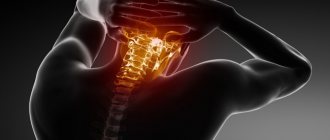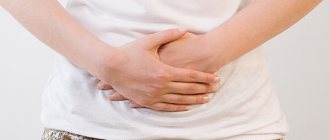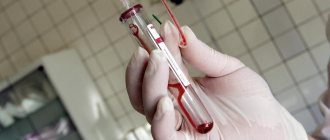Pain in the navel area accompanies various diseases that are dangerous to the health of adults and children. Diseases are associated with organs that are located in this area: the colon, loops of the small intestine, the ascending and lower parts of the initial part of the small intestine, the large fold of the splanchnic peritoneum, the upper parts of the ureter and kidneys, the greater curvature of the stomach.
Frequent pain in the navel area warns of illness
Causes of pain near the navel in women
Depending on the intensity and irradiation of the discomfort that occurs, the cause of the pain may vary significantly.
Experts in the field of gastroenterology argue that in such cases you should seek help from a doctor as soon as possible, since even mild pain may indicate serious pathologies. Moreover, these can be diseases of the gastrointestinal tract, diseases of the renal system, or in general the incubation period of serious and life-threatening intestinal infections.
Stomach problems
In terms of frequency of occurrence, abdominal pain above the navel is the most common.
The obvious reason for this is that in this area there are the most important organs, penetrated by a huge number of nerve endings and exposed to the direct influence of a variety of foods, which can affect the gastrointestinal tract in a completely unfriendly manner. Good innervation of the organs, in turn, contributes to the fact that the slightest negative impact immediately responds with pain. Describing pain is an individual process. For example, a doctor may hear the following from a patient: “Strange pain in the abdomen above the navel.” Therefore, to accurately diagnose the disorders that have arisen, it is necessary to conduct a number of different studies - from a simple clinical blood test to state-of-the-art CMT and MRI. And only then can you accurately explain why the pain in the abdomen above the navel occurred.
The disease begins with very harmless, as many people mistakenly believe, symptoms. The mucous membrane in this disease is affected for many reasons of different nature. The most common factor is the bacterium Helicobacter pylori.
In any case, untreated gastritis risks developing into a peptic ulcer. At its core, an ulcer is an open wound. At first it affects only the mucous membrane of the diseased organ. And then, growing like rust on iron, it “eats” both muscle and vascular tissue.
The result may be internal bleeding. If you do not receive qualified treatment at this stage, then perforation of the organ is possible. At this stage, the ulcer completely destroys its wall. And this is fraught not only with blood loss, but also with infection of the abdominal cavity, that is, peritonitis. This is an unpleasant and very dangerous phenomenon, which even in progressive countries is characterized by a mortality rate of 50-60% of cases. And it all can start with such a symptom as not very severe pain in the abdomen above the navel.
Main features of pain in the navel area
The first thing the patient must report is the nature and intensity of the pain. Depending on the location and nature of the pain, one of the possible causes of this discomfort can be determined. Along with this, report any other symptoms - nausea, bowel movements, dizziness, and so on.
For a more accurate diagnosis, the doctor may prescribe a number of laboratory tests and diagnostic procedures.
If you notice acute pain with significant intensity, this is a reason to call an ambulance or immediately go to see a doctor. This may indicate very serious pathological processes in the body, for example, peritonitis, which poses a threat to human life.
What does it mean if it hurts above the navel?
Only a specialist can say what pathology provoked the development of pain syndrome, so a person needs to go to a medical institution and undergo a comprehensive examination:
- People are required to undergo all basic tests: urine, stool, blood.
- As a rule, this category of patients is required to undergo fibrogastroduodenoscopy. Thanks to this diagnostic procedure, specialists are able to examine the gastrointestinal tract and identify lesions.
- If a person is suspected of having a pathogenic microflora, for example Helicobacter, then a biopsy and urease testing are prescribed.
- An ultrasound examination of the gastrointestinal tract is performed. Experts recommend that all people over 40 years of age undergo this examination at least once a year.
- If there is suspicion of the development of malignant neoplasms, CT or MRI is prescribed.
Pathologies of the small intestine
Impaired intestinal permeability is a very dangerous condition that requires special attention. Moreover, in the absence of proper treatment, even a fatal outcome cannot be ruled out.
The lumen of the small intestine may narrow as a result of the following factors:
- mechanical - the presence of gallstones, malignant and benign tumors, helminthic infestations;
- compressive - the formation of so-called intestinal adhesions or even intestinal volvulus.
How does the liver and gallbladder hurt?
Hepatitis - inflammation of the liver parenchyma - does not cause severe pain; patients complain of a feeling of heaviness, fullness in the epigastrium and right hypochondrium. The disease causes loss of all organ functions.
Therefore, severe intoxication manifests itself: high fever, nausea, dizziness. Diarrhea is a consequence of impaired synthesis of digestive enzymes. Failure of hormonal balance during a long course of hepatitis leads to infertility in adult men and women.
Liver damage, in addition to pain, is characterized by the following symptoms. Yellowness of the skin, sclera, and mucous membranes is caused by impaired outflow of bile and destruction of hepatocytes. The feces become light-colored and the urine darkens due to altered metabolism of the bilirubin pigment.
Manifestations of portal hypertension - increased pressure in the vessels of the portal vein (with cirrhosis):
- dilation of the veins of the esophagus, the anterior wall of the abdomen (“head of the jellyfish”);
- ascites in the abdominal cavity (fluid accumulation);
- enlargement of the spleen due to the deposition of part of the blood.
Hepatic encephalopathy - fatigue, apathy, drowsiness and impaired consciousness up to coma, are associated with the cessation of detoxification and the effect of toxic waste on the brain. Hepatic colic refers to attacks of pain caused by spasm or obstruction of the gallbladder and ducts. They are caused by the advancement of stones or disruption of the nervous regulation of smooth muscles (dyskinesia).
Gallstone disease is manifested by cramping pain under the ribs on the right with irradiation into the epigastrium, into the chest to the level of the collarbone, into the shoulder, and scapula. At the same time, nausea and bitter vomiting appear, which does not bring relief to the patient. An attack can last several hours and be accompanied by fever, chills, weakness, and headache.
A mechanical obstruction in the bile ducts can be judged by yellowness of the skin and sclera, and itching.
Disturbed central regulation causes too much spastic contraction of the bile ducts or relaxation
Dyskinesia of the hyper- or hypokinetic type is characteristic of people who are nervous, emotional, and prone to worry. The patient feels either cramping, short-term pain, or dull pain caused by stretching and overflow of bile. The symptom is regarded as a harbinger of cholecystitis.
Acute cholecystitis is an inflammation of the gallbladder wall, often combined with the presence of stones, then called calculous. The onset is usually sudden, at night. Obese women are most susceptible to the disease. In the chronic course, attacks are provoked by poor diet (fatty and fried foods), physical activity, stress, and shaking in transport.
Each exacerbation causes attacks of pain in the upper abdomen on the right. During the interictal period, patients feel dull pain in the abdomen, back, nausea, suffer from heartburn, unstable stools, flatulence, and itchy skin. Headaches, insomnia, weakness, and memory loss occur.
Particular attention is paid to the possibility of liver injury. Doctors urgently need to find out why the stomach hurts during accidents, a fall, or an accident. The organ is damaged by a fracture of the ribs, and the capsule ruptures from a mechanical shock.
The pain is localized in the victim's upper abdomen and radiates to the right collarbone and scapula. The intensity depends on the severity of the damage. A typical symptom of “Vanka-Vstanka” is increased pain in a horizontal position and weakens in a sitting position, so the victim always refuses to lie down.
Liver injury is dangerous due to the development of massive internal bleeding. It cannot stop spontaneously; the blood is mixed with bile and loses its ability to clot. The person becomes pale, blood pressure decreases, and sticky sweat appears on the skin. The condition is life-threatening. Emergency measures are needed.
Poor circulation in the intestines
Typically, chronic intestinal ischemia occurs due to cerebral atherosclerosis or aortoarteritis.
The pain is also cramping in nature, but spreads not only to the navel area, but also to the epigastric region, most often occurring 30-40 minutes after eating. In this case, to make the patient feel better, it will be enough to take a Nitroglycerin tablet once.
After this, you should consult a doctor, since in the absence of proper therapy, the disease can quickly progress, provoking the development of the following signs of impaired blood circulation:
- sudden weight loss;
- the appearance of constant bloating and excessive gas formation, a feeling of fullness appears, which is accompanied by stool disorders.
The pathology is easily treated with a number of pharmacological drugs. But this is the case at the initial stage. Therefore, even a slight pain syndrome is a reason to visit a doctor.
What is this symptom if it hurts above the navel?
Modern medicine separately identifies “red flag” symptoms, which indicate the development of life-threatening pathologies.
As a rule, if such signs are present, patients require emergency hospitalization followed by surgical intervention. In parallel with pain in the umbilical area, people experience the following symptoms:
- Vomiting begins. In this category of patients, the vomit acquires a consistency similar to coffee grounds. They often contain blood impurities. Also, blood streaks and clots are found in the stool, causing it to change color and become black.
- A dagger-shaped pain syndrome occurs in the epigastric zone.
- The patient's swallowing functions are impaired.
- On the anterior wall of the peritoneum, muscle tissue tension is observed, which indicates the development of peritonitis.
- Unreasonable weight loss occurs. People develop disgust even for their favorite foods. This condition indicates the development of neoplasms.
- There are signs of intestinal obstruction, in which foul-smelling belching, vomiting, and constipation appear. The development of pyloric stenosis may occur.
- In people over 45 years of age, symptoms appear that indicate damage to the gastrointestinal tract.
- With progressive weakness, increased sweating, and fainting conditions, the intensity of the pain syndrome may decrease. This will indicate new bleeding.
Enzyme deficiency
Enzyme-deficiency enteropathies cause pain in the navel area in women and men. And this kind of pathology usually occurs due to a lack of digestive enzymes. Such diseases differ in congenital or acquired origin, and often provoke defective parietal digestion.
Signs appear as intolerance to certain foods.
The main danger is the lack of timely diagnosis, especially in childhood, which provokes a lag in mental and physical development.
Enteropathies are characterized by the following symptoms:
- excessive gas formation;
- diarrhea, in which there is the release of feces with particles of undigested food;
- frequent nausea, which leads to bouts of vomiting, after which the patient’s condition does not improve much.
You can eliminate cutting and any other pain in the navel area only by getting rid of the main cause.
In the case of enteropathies, an integrated approach to treatment is required, in which you should avoid products that provoke the development of pathological processes. Along with this, enzyme preparations are prescribed.
Treatment methods
If specialists, in the process of carrying out diagnostic measures, have identified the cause of the development of pain in the gastrointestinal tract, then a drug therapy regimen will be individually developed for each patient:
- To combat pathogenic microflora, tablets “Hemomycin”, “Supraxa”, “Tsiprolet”, “Tetracycline”, “Amoxiclav”, “Amoxicillin” are prescribed.
- To prevent flatulence and eliminate gases in the stomach, Disflatil, Kolikida, and Espumisan tablets are prescribed.
- To remove toxic substances from the human body, the following medications are prescribed: Filtrum, Smecta, Neosmectin.
- To protect the gastric mucosa from the harmful effects of acids, tablets that are part of the group of proton pump inhibitors are prescribed. For example, “Omez”, “Omeprazole”.
- To eliminate constipation, patients are advised to take Guttalax, Duflac, Microlax.
To normalize digestive processes, patients are recommended to take enzyme-containing medications.
For example, tablets “Creon”, “Mezima”, “Pancreatin”, as well as:
- Doctors can prescribe medications to patients that fall into the category of anti-inflammatory non-steroidal medications. For example, Ketorolac and Ibuprofen tablets.
- To eliminate spasms, No-Shpy and Papaverine tablets are prescribed.
- If indicated, patients are prescribed hormone-containing contraceptives that contain progesterone and estrogens, for example, tablets “Chloe”, “Zhanina”.
- In addition to medications for this category of patients, dietary nutrition is recommended, which will normalize digestive processes.
Oncological pathologies
If the pain is constant, then this indicates a chronic form of the disease, which occurs with certain complications.
Among the main signs that may indicate the presence of malignant processes are the following symptoms:
- rapid and constant fatigue;
- disturbances in peristalsis and digestion;
- sudden appearance of high body temperature.
Oncological pathologies of the middle section of the small intestine are a rarely diagnosed disease that requires urgent treatment.
Its main features:
- severe cramping pain in the navel area;
- constant nausea and belching;
- heartburn, frequent rumbling in the stomach;
- regular bowel movements, especially diarrhea.
The appearance of tarry stool is another characteristic symptom of cancer. This usually indicates the rapid development of iron deficiency anemia.
There is only one treatment method - surgery to remove malignant tumors; if necessary, it may even be necessary to remove part of the organ. Chemotherapy or radiation therapy will also be required in the future.
Methods for diagnosing the cause of pain
When figuring out why the stomach hurts in the navel area, doctors pay great attention to the patient’s sensations. Despite the severity of the situation, it is very important to obtain detailed information about the characteristics of pain symptoms:
- time of onset of the pain syndrome, features of its development (suddenly or progressively);
- nature of the pain (sharp, nagging, spasmodic);
- how long does an individual spasm last and with what frequency;
- what actions are associated with the phenomenon (load, food intake, nervous stress);
- in what direction is it localized (degree of displacement from the navel, presence of radiating pain);
- reaction to painkillers.
So, if your stomach hurts directly in the navel area and below, Crohn's disease, enteritis, colitis, and diseases of the genitourinary system are suspected; above the navel – diseases of the epigastrium and the stomach itself are added. If the pain moves to the right - appendicitis.
On a note! There is a possibility of so-called somatic pain, when the peritoneal organs are not damaged, and sensitivity is associated with irritation of the spinal nerves.
After collecting anamnesis, additional studies are carried out using laboratory and instrumental methods:
- blood and stool test (general, biochemical);
- genetic research;
- Ultrasound of the abdominal organs;
- magnetic resonance imaging (MRI);
- irrigography (intestinal x-ray with contrast);
- colonoscopy.
IBS – irritable bowel syndrome
With IBS, there is impaired intestinal motility, digestive disorders, pain in the navel, which is similar in nature to contractions. Most often, the pathology occurs specifically in the fairer sex, the cause of which is neurological disorders and poor nutrition.
We recommend
Can I have periods during pregnancy?
Along with discomfort and pain in the navel, a woman may experience constant constipation, diarrhea, and the appearance of fecal matter with a large amount of mucus.
Gradually, pain from the navel area begins to radiate to the right side and to the epigastric region. Typically, symptoms occur in the morning.
Painful feeling in childhood
Why does the stomach hurt above the navel in childhood?
This question is often asked by parents whose children are not yet 6 years old. If a child has pain on the right or left, the cause may be:
- regular exposure to stressful situations;
- development of lactose deficiency;
- reflux;
- errors in nutrition;
- earlier introduction of complementary foods.
If a child has a stomach ache above the navel due to stressful situations, then this phenomenon is usually called a functional disorder. It is more common in children who are hyperactive and mobile due to dysfunction of the nervous system. Pain in the umbilical region is not considered dangerous, but it causes a lot of discomfort to the child.
Another main cause of pain in the navel is lactose deficiency. Often diagnosed in infants and preschool children. The mechanism of occurrence of pathology is based on a lack of enzymes that break down lactose. This component is found in dairy products, so they are always excluded from the diet if an allergy is detected.
Unpleasant sensations in the abdomen are also accompanied by a disease such as reflux. It is characterized by the throwing of stomach contents back into the esophageal tube. Has additional symptoms such as constipation and other digestive disorders.
The cause of pain in the navel can be an error in nutrition, when the diet does not have enough foods with fiber and liquid.
Other intestinal pathologies
In addition to all the above reasons, pain in the navel area can also appear for other, more banal reasons. Even simply overeating or eating heavy foods can cause discomfort and pain.
Nonspecific ulcerative colitis
This disease can develop for many reasons, which provokes the formation of ulcerative and necrotic lesions on the intestinal mucosa. The main symptoms are the development of abdominal pain and the appearance of bloody spots in loose stools.
In this case, the body temperature can be stable, especially in the case of a chronic form of the disease. The patient experiences frequent but false urges to defecate and suffers from bloating.
An obligatory stage in diagnosis is endoscopic and x-ray examination methods.
Crohn's disease
This is the name of the pathology granulomatous enteritis, which affects various parts of the intestine. The disease is characterized by the presence of an inflammatory process. Due to intoxication, the patient experiences the following symptoms:
- hyperthermia;
- nausea, vomiting, loss of appetite and sudden weight loss;
- fatigue and constant feeling of weakness;
- rumbling and seething in the intestines;
- soreness in the navel area.
The main dangerous complication is intestinal perforation. No less dangerous results are also possible - the appearance of fistulas in the bladder area or toxic megacolon.
Crohn's disease is not so easy to treat; the patient is forced to constantly take pharmacological medications.
Mesandenitis
Viral and bacterial infections of the intestines also often cause pain in the navel area. At one time, this provokes inflammatory processes in the area of the mesenteric lymph nodes.
The disease can manifest itself under the influence of these microorganisms:
tuberculosis microbacteria;
- shigella;
- Klebsiella;
- salmonella;
- staphylococci;
- enteroviruses;
- adenoviruses.
The pathology is characterized by sharp, severe pain in the navel area, which has a paroxysmal nature. Along with this, the patient may note the appearance of symptoms indicating intoxication of the body.
Treatment is quite simple - it is taking anti-inflammatory drugs and antibiotics that have a wide spectrum of action.
When a doctor's help is needed
Most people try to cope with the pathological process on their own. But, unfortunately, medications cannot always help solve the problem.
You need to call an ambulance:
- for pain that does not go away within 3 hours even after taking antispasmodics and analgesics;
- severe nausea, repeated vomiting and diarrhea. Especially when the masses acquire a darkish tint;
- in case of impaired swallowing or respiratory function;
- with tension in the muscle structures of the anterior wall of the abdominal cavity;
- progressive weakness, sweating, fever;
- development of fainting;
- with bleeding from the rectum or vagina.
Such signs signal the emergence of serious problems and require urgent surgical intervention.
Warning signs
It is worth paying attention if the pain appeared suddenly, but there were no such symptoms before. Painful sensations in the period after surgery on the abdominal organs are cause for concern.
Inflammatory processes in the abdominal cavity and pelvic organs are always accompanied by an increase in body temperature. In such cases, it is necessary to consult a doctor in advance and eliminate the infection.
Pyelonephritis often occurs as a complication of various infectious diseases, for example, purulent tonsillitis, because bacteria are carried with the blood into the renal pelvis. If after 3-4 days after a sore throat the kidneys begin to hurt, it is necessary to send the person to the hospital.
In cases of rapid deterioration in health, it is better not to wait for improvement, but to call an ambulance, which will take the patient to the surgical department. If there are no indications for surgical intervention, the patient is referred for examination to gastroenterologists, urologists or gynecologists.
Ulcerative processes
A person has pain above the navel in the abdomen due to gastric and duodenal ulcers. He can describe the manifestations of pain like this :
- arise in the epigastrium, can radiate to the lumbar region, chest, back, descend low or rise from the initial focus;
- sensations often appear at night;
- soreness refers to “hungry”, that is, it becomes bright a few hours after eating;
- may appear at other times - early (an hour later) or late (two hours later) after feeding;
- A characteristic sign of pain in the area above the navel is its seasonality.
© shutterstock
Nausea, vomiting, complete reluctance to eat, painful appearance, thinness are additional signs indicating the development of an ulcerative process in the digestive system. The choice of treatment for the disease depends on the development of the pathology; it can be medicinal or surgical.
Prevention
Prevention of pain depends on its cause. If it is infectious colitis, gastroenteritis, or jeunitis, then it is recommended to follow the rules of personal hygiene. Bacteria are transmitted through dirty hands and insufficiently cleaned utensils. You should:
- wash your hands before and after eating with soap;
- do not eat food on the street or in public transport;
- Avoid suspicious eating places.
It is extremely difficult to prevent autoimmune pathologies such as Crohn's disease or ulcerative colitis, as well as appendicitis. These diseases do not have a specific cause that can be prevented.
Watch the following video, it may be very helpful
To the right of the navel
The gate of the right kidney, as well as the ascending colon, are located in this area. With kidney pathologies, pain is noted on the right front, as well as in the back.
An attack of appendicitis begins with a person having pain in the navel, and then the pain gradually shifts to the right side.
Pain to the right of the navel is also caused by changes in the small or large intestine. Pain can indicate acute or chronic pathology.
Depending on the symptoms, the person requires emergency medical attention or observation.
Inflammation of the cecum is one of the common causes of navel pain in men, especially on the right side. The cecum is the section of the large intestine that is located in the lower right side of the abdomen. Its inflammation can be caused by infection - Escherichia, Salmonella, Shigella.
There is non-infectious inflammation of the cecum - ulcerative colitis, Crohn's disease.
Pain in lesions of the cecum is acute, paroxysmal. They are combined with diarrhea. Severe dehydration rarely occurs, since the main fluid enters the body above the site of inflammation.
Diagnosis of inflammation of the cecum is carried out by a gastroenterologist or infectious disease specialist. A general blood test shows signs of inflammation. Colonoscopy, stool examination and culture to determine bacteria are also performed. Treatment is carried out with antibiotics or anti-inflammatory drugs, depending on the source of inflammation.
Non-infectious intestinal inflammation - Crohn's disease, ulcerative colitis - are treated for life.
Appendicitis
The diagnosis of appendicitis is made by a surgeon in the emergency department. If the diagnosis is confirmed, the patient will be operated on within the next 24 hours.
The inflamed appendix is removed, and after surgery antibiotics are prescribed to prevent peritonitis.
Gallbladder
To the right of the navel, pain is accompanied by inflammation of the gallbladder - cholecystitis. Paroxysmal pain is caused by a violation of the diet, namely: overeating fatty, fried foods, and alcohol abuse.
A surgeon can confirm an attack of biliary colic with cholecystitis. Additionally, an ultrasound examination will be required. It will show if there are stones inside the gallbladder that need to be removed.
If gallstone disease is detected, the bladder will be removed as soon as the acute inflammation subsides. To get rid of acute pain due to colic, antispasmodics are prescribed: papaverine, platyphylline, no-shpu.
Cholecystitis is less common in men than in women.
Possible causes of pain
Diseases of the genital organs
Pain in the hypogastrium may indicate pathology of the genitourinary system. This is referred pain that occurs against the background of other unpleasant sensations. At the same time, the man feels pain in the perineum, scrotum, and rectum. Quite rarely, discomfort in the lower abdomen is the only symptom, and in this case, additional examination methods are necessary to make a diagnosis.
- Prostatitis is inflammation of the prostate gland. Pain below the navel is combined with unpleasant sensations in the scrotum and perineum. Dysuric phenomena are added (discomfort when urinating), erectile dysfunction is possible.
- Prostate tumor (adenoma, cancer) – pain occurs when the tumor is large and is noted in the lower abdomen, lower back and perineum.
- Vesiculitis is inflammation of the seminal vesicles. Pain below the navel, in the groin area and lower back is combined with unpleasant sensations during erection and ejaculation.
- Diseases of the testicles (orchitis, tumors) - pain in the lower abdomen is combined with pain in the perineum, an increase in the size of the testicle.
Diseases of the urinary system
Pain below the navel, combined with dysuric symptoms, may be a sign of the following pathology:
- Pyelonephritis is inflammation of the kidneys. The pain initially occurs in the lower back, radiating to the lower abdomen (usually on one side). Possible increase in body temperature.
- Cystitis is inflammation of the bladder. The pain is localized centrally in the hypogastrium and occurs against the background of frequent and painful urination.
- Urethritis is inflammation of the urethra. The pain is localized in the perineum and can radiate to the lower abdomen and sacrum.
- Urolithiasis disease. When stones form in the kidneys or ureters, the pain is usually localized in the lumbar region on one side, radiates to the lower abdomen and goes to the thigh. The pain can be quite intense. Loss of consciousness and acute urinary retention are possible.
Appendicitis - acute attack
Acute attacks of pain to the right of the navel are appendicitis; many people confidently know the symptoms of this most dangerous phenomenon. The attack begins with a painful sensation in all areas of the abdomen, which is not localized, but is also observed in the umbilical region. This stage gives vague symptoms, and it is difficult to diagnose the cause of the patient’s condition.
After two to three hours, the sensation is localized in the lower right part of the abdominal cavity, the pain becomes constant, and the patient’s condition worsens when walking. When lying in bed, changing position causes new attacks and increases pain. Nausea is observed - 1-2 times, refusal of food, appetite disappears completely. The temperature rises to 38 degrees, often a slight rise.
Touching the lower abdomen hurts. You should go to the hospital or call doctors urgently; inflammation of the organ can lead to perforation, causing the contents to spread throughout the abdominal cavity, leading to peritonitis.
Diseases with pain syndrome
Each pathology, in addition to pain in the umbilical area, is characterized by certain symptoms.
Jejunal obstruction
Lack of jejunal patency is one of the most severe conditions. If medical care is not provided, it can cause death. A blockage of the intestinal lumen can be caused by a stone, a tumor, a lump of worms, or squeezing it from the outside, for example, by adhesions.
In a child, pathology can be provoked by intussusception - penetration of an intestinal loop into the neighboring intestine. A symptom of the pathology is increasing cramping pain in the middle of the abdomen. Uncontrollable vomiting, which also includes intestinal contents, brings relief only for a short period of time. There is also stool retention and passing of gas.
Then the pain goes away, but the patient’s general well-being rapidly deteriorates. There is a drop in blood pressure and heart rhythm disturbances - tachycardia develops. Lack of medical care leads to death.
Exacerbation of chronic jeunitis
Chronic jejunitis is a long-term inflammation of the jejunum. The pathology is accompanied by the following symptoms:
- development of spastic pains affecting the middle of the abdomen (caused by spasms of the intestinal wall);
- flatulence;
- inflammatory process in the lymph nodes of the mesentery - pain in this case is determined below/to the right of the navel and in the area of the left hypochondrium.
The disease is characterized by severe diarrhea that occurs after eating. If the condition worsens, the risk of developing gangliolitis is high. With such an outcome, the nature of the pain changes: it transforms from spastic to burning.
Irritable bowel syndrome
Irritable bowel syndrome is one of the causes of pain in the lower abdomen in the middle. The pathology refers to functional diseases of the gastrointestinal tract and is quite common, being diagnosed in men and women. Moreover, among female representatives it occurs 2 times more often.
Symptoms of irritable bowel syndrome include:
- impaired intestinal motility - diarrhea alternating with constipation;
- increased gas formation;
- cramping pain above/below the navel.
Pathological symptoms particularly bother the patient in the first half of the day. Cutting pains, localized just below the navel, form immediately after breakfast and end with diarrhea. The person feels relieved. During the day, heartburn and belching appear. The pain persists, but in the evening and throughout the night all the heavy sensations recede.
Violation of the blood vessels of the mesentery
The cause of the condition is blockage of the mesenteric vessels by blood clots. Most often it forms in people with diagnosed heart and vascular diseases. The pathology is characterized by severe cramping pain localized in the navel area. Some reduction in pain occurs when a person takes a knee-elbow position.
The pain is practically uncontrollable even with the administration of morphine derivatives. During an attack, the patient experiences cold, sticky sweat, increased blood pressure and severe tachycardia. Later, vomiting and diarrhea join the symptoms.
After six to twelve hours, the pain subsides, which is explained by the death of the nerve receptors of the intestine. Blood appears in vomit and feces. If left untreated, the patient develops peritonitis, and in the worst case, death.
Enzyme deficiency
Enzyme deficiency (enzyme deficiency enteropathy) develops as a result of insufficient production of certain types of enzymes. The condition can be either congenital or acquired, leading to disruption of the processes of parietal digestion.
Clinically, the pathology is accompanied by intolerance to certain types of foods. The most common diagnosis is gluten intolerance. Signs of the condition include: pain near the navel, gas formation, diarrhea with light-colored feces containing pieces of undigested food.
To prevent the development of pathological symptoms, it is necessary to completely exclude from the diet all foods to which a person is intolerant. The patient is required to take enzyme preparations.
Pain caused by spinal osteochondrosis
Osteochondrosis is formed by degenerative changes in the discs between the vertebrae. In this case, a person experiences chronic pain in the upper abdomen, reminiscent of gastritis. They intensify not from eating, but when turning the body, physical work, and noticeably subside after rest. The doctor identifies the most painful points by palpating the paravertebral area.
Deformation in the lower thoracic region contributes to compression of the nerve roots emanating from the spinal canal
Pain in the abdomen and spine in advanced pregnant women requires special attention. If a woman’s spine is not accustomed to physical activity, then the weight of the fetus is perceived with difficulty. The pain is caused by sprained ligaments of the intervertebral joints. They go away after childbirth.
Modern types of examination make it possible to identify the cause and clarify the nature of damage to the organs of the upper abdomen. Patients are not recommended to endure and try to treat themselves. This can cause complications and complicate further treatment.











